How a simple, DIY-inspired design helped create the worlds most dangerous flying corps.
When World War 1 came to an end in 1918, the victorious allies took care to heavily restrict the military development of powered flight in the Treaty of Versailles. It wasn't long however, until the land of the Red Baron discovered a loophole wherein the treaty overlooked the use of unpowered flight as a military training tool. The resulting training regime used a brilliantly simple design called a Schulgleiter(English: School glider) and arguably produced the finest airmen in all of WWII (at least when evaluating individual skills alone...).
For a regime better known for engineering achievements like the ME-262 (the world's first jet fighter), than for inspired design practices as those that produced Russia's T-34 Tank or Britain's plywood Mosquito Bomber, the Schulgleiter is truly extraordinary. Officially designated the DFS-SG-38 Schulgleiter, the craft had a simple stick for steering, foot pedals for flaps and little else.
The gliders would be launched by a giant bungee chord on a mountain known as the Wasserkuppe where gentle slopes and perfect tailwinds make it the heart of German aviation to this very day. The following image shows a Schulgleiter in mid-launch position, and the 1940 vintage training video shows how the process worked.
With such ideal flight conditions, the SchulGleiter was far from the only aircraft developed at the Wasserkuppe, nor was it the only advance in unpowered flight at the time. The Horten Brothers are best known for developing the Ho-229. A jet-powered, Flying Wing with characteristics so far ahead of its time, that Northrop Grumman, designers of the B2 Stealth bomber, famously constructed a replica for the purposes of testing its stealth characteristics.
While the Ho-229 has attracted a sizable following of aircraft modelers and enthusiasts, less attention has focused on the fact that such a high-tech marvel is almost entirely derived from seemingly low-tech glider designs. Going back as far as the First World War, the Horten's had been developing the flying wing concept as a glider. Such designs might appear familiar to readers of DIYDrones, though some might warrant further research.
Of the unpowered-wings, the best known is perhaps the Horton H.IV whose extremely broad, thin wingspan was a breakthrough in tailless aircraft design.
I am highly interested to learn if other contributors to the DIYDRONES community have tested similar airfoil/wingspan designs or are aware of detailed blueprints for Horten wings or other prewar German glider designs.
Furthermore, I would like to examine where present work on DIYDrones might apply to simple manned craft like the SchulGleiter.
AFAIK the Wasserkuppe is still a popular location for Gliders and RC aircraft and currently houses the German Sailplane Museum. Please feel free to comment if you have flown at this location or are interested in the subject in general.
*This is the first post of what I hope to be a series of blog posts, tutorials and curricular guides under the hashtag #makinghistory. MH entries will examine historical antecedents to contemporary practices in the DIY, Open Source, Maker and Civic Hacking movements.








Comments
I'm with Wayne on this one. A Nürflugel isn't (necessarily) more efficient than a conventional aircraft because the maximum practical lift coefficient you can achieve is somewhere around the 0.7-ish mark. There's also limited ways to implement high-lift devices. On a conventional aircraft where pitch stability is separated from the main lifting surface, you can see Cl_max north of 1.2 and way more than that depending on what you reference as your wing area. That means for a given stall speed, you can run with 0.7/1.2 = 60% of the wing area (broad-brush figures here) with a conventional aircraft.
Given that form drag is directly proportional to wing area, this is a huge advantage over the Nürflugel even if you waste some in having a tail.
Loved this video of a classic Schulgleiter glider.
Andrew and Gary,
"This is just Aerodynamics 101 stuff" ya that's just the problem . Now if you would like to study Aerodynamics 201, maybe you should check out some of my designs.
The Techwing. Highest Cl max flying wing available on the market.
the techpod. highest cost to endurance ratio available on the market. The problem is that in order to be stable all aircraft must generate down force ( except for forward swept case). in a traditional design. this happens well aft of the area where lift is being generated. In a back swept wing, especially in the case of the horten, the wing tips are twisted downward so much as to produce down force. Your idea that "A pure wing (Nurflugel) is more efficient by definition because the airframe is entirely devoted to generating lift" is false. In other words the word "tail-less" is a misnomer. Its more like the tail has been removed and added to the swept back portion of the wing. The tail is there you just cant see it so plainly. Yes never adding winglets limited the viability of the design. First thing I did was a thorough CFD analysis of the horton design along with northrops, zagi, zepher, and a few other flying wing examples. The best turned out to be the mersk pioneer, forward swept of course.
> I have read in a number of sources that the Ho IV suffered from stability issues due to an unforgiving C.O.G.
What I remember reading was that pilots complained about yaw stability or skidding in turns, something like that but my memory is a bit foggy. That was from the Myhra book I mentioned earlier. I found this report based on post-war flight testing of the Horten IV. It doesn't mention the handling problems, mainly it criticizes the drag produced by the airfoil.
The ventral gondola was mainly to accommodate the pilot's legs for greater comfort. Some of the earlier Horten designs had a pure prone position which has some issues. And yes, the gondola was mainly parasitic drag :-) though it did have enough benefit to be deemed worth it.
Gary
I second Andrew's comment. This is just Aerodynamics 101 stuff. A pure wing (Nurflugel) is more efficient by definition because the airframe is entirely devoted to generating lift. Fuselage and tail surfaces generate what aerodynamicists call 'parasitic drag'. The word "parasite" is carefully chosen! These surfaces are only for carrying payloads (fuselage) and stability (tail). They contribute nothing to the primary goal (lift).
This is why Reimar Horten was so obsessive about the Nurflugel idea. He flatly refused to put any vertical surface on his designs, despite a lot of pressure to do so. Some model builders have put wing fences on their Horten models. This is heresy as far as I'm concerned! :-) Reimar would be turning over in his grave!
Gary
Not to keep piling on to the first comment but I must've overlooked this earlier-
So I'll just go ahead and say it... FLYING WINGS ARE INHERENTLY MORE EFFICIENT THAN CONVENTIONAL AIRCRAFT! Of course, they are also inherently unstable and until the advent of electronic stabilization this issue negated any aerodynamic advantage.
This makes the Horten Gliders all the more interesting IMHO, as they had to try to compensate for these inherent challenges through the design itself.
I have read in a number of sources that the Ho IV suffered from stability issues due to an unforgiving C.O.G. Is this because it has such a broad wing sweep in proportion to the chord? Is that enormous bulge coming out of the bottom meant to balance the C.O.G or for payload? Is there any advantage to this design feature that you are aware of?
Hi Andrew,
Great post and interesting angle on the Schulgleiter. I have always maintained that the best way to learn to fly is to start with gliders. That's how I started and it is the advice I have always given to new R/C pilots. Few of them heed it however :-)
> The one major fact I was a little worried about in the post was whether or not it actually was Northtrop Grumman who tested the Stealth characteristics of the Ho.229.
Indeed it was Northrop Grumman! I visited three times while the work was being done. The plant is in El Segundo near LAX. The historical reenactment filming was done at a small airfield in Inyokern, CA, near China Lake.
Gary
Andrew, I am following this post with great interest and commend you in the way you have written this post.
There exists a strong correlation between the art of gliding and what makes a pilot a fighter ace, in the Luftwaffe this can be seen with pilots like Adolf Galland, Erich Hartmann, Herman Graf etc. All glider pilots before the start of WWII.
I believe the art of gliding would have given these pilots an edge over other pilots who have only trained on powered aircraft before going into battle. A glider pilot knows how to use the most of the sky and get the most from his aircraft, keeping up enough air over the wings especially at slow speeds, during steep banking manouvers and how to recover from a stall with ease where in contrast a non-glider pilot would not.
Also note that the mentioned pilots(all war aces and glider pilots) were at some stage forced to make numerous crash landings and survived to fight again. The knowledge of gliding a dead stick.
It looks like my hunch that DIYDrones would be the right crowd for this post turned out to be correct!!! The one major fact I was a little worried about in the post was whether or not it actually was Northtrop Grumman who tested the Stealth characteristics of the Ho.229. I know it wasnt SkunkWorks and I seemed to remember it being NG, but was I correct? I would definitely want to edit this out if it was incorrect...
As opposed to "big" mistakes like pedals/flaps and tailwinds/headwinds-
Well, technically I am a DIYDrones NOOB, though I've been on Publiclab, Arduino, MultiWii etc... At least it didnt take me very long to find the guy who loves pointing out minor mistakes that have no relevance on the overall narrative :) Though they generally do turn out to be the most knowlegable when all is said and done... As long as they have a sense of humor...
Yes, that hook line went through a few revisions since I had to find a relatively neutral term that conveys how Luftwaffe pilots were really, really good at flying even though they were fighting for a really really bad cause. I know there's always a debate about how the numbers of fighter kills in WW2 are skewed in the Luftwaffe's favor, but even the best Allied aces have no qualms pointing out the superior skill of the average German pilot. My point is that much of this skill can be traced to the sheer simplicity of the Schulgleiter, which must've been the closest thing to flying like a bird that existed at the time.
I've heard the same thing said about Soviet technology and honestly I think such an evaluation is dangerously flawed. My point about the Schulgleiter is that it complicates the conventional interpretation of WW2-era Germany as neglecting good design for engineering prowess. Just like other celebrated designs of WW2 (e.g the T-34 and the Mosquito) the Schulgleiter was created as an ingenious response to the restrictions of the Versailles Treaty. The fact, that Germany embraced a different path with the Tiger Tank, the ME-262, the V-Weapons etc... had much less to do with "trying anything" and more to do with satisfying the whims of a single madman who nobody dared question.
There might be a little more to the "who cares if anyone dies" evaluation if it were applied to Soviet Russia where Stalin's famous "quantity has a quality all of its own" maxim could certainly be read against his undeniable disregard for human life. Yet to claim, as many western "experts" do, that the Soviets won the war by using their soldiers as cannon fodder, not only ignores the genius of leaders like Zhukov, and Chuikov but fails to explain how masses of untrained cannon fodder would ultimately win the war through mastery of small unit urban warfare.
If anyone was treated as an expendable quantity by their own forces look no further than the US Army Tank Corps, who continued to push weary G.Is into the under-gunned and under-armored M4 Sherman's until the very end of the war...
But I Digress... Back to the subject at hand...
Any more thoughts about the Schulgleiter? Has anybody ever built one? Has anybody ever been to the Wasserkuppe? I forgot to mention that there was a US Military installation there during the Cold War so some people may have been stationed there as well.
I
-
1
-
2
-
3
of 3 Next